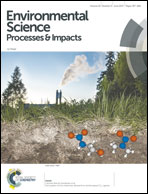Probing the interactions of organic molecules, nanomaterials, and microbes with solid surfaces using quartz crystal microbalances: methodology, advantages, and limitations†
Abstract
Quartz crystal microbalances (QCMs) provide a new analytical opportunity and prospect to characterize many environmental processes at solid/liquid interfaces, thanks to their almost real-time measurement of physicochemical changes on their quartz sensor. This work reviews the applications of QCMs in probing the interactions of organic molecules, nanomaterials (NMs) and microbes with solid surfaces. These interfacial interactions are relevant to critical environmental processes such as biofilm formation, fate and transport of NMs, fouling in engineering systems and antifouling practices. The high sensitivity, real-time monitoring, and simultaneous frequency and dissipation measurements make QCM-D a unique technique that helps reveal the interaction mechanisms for the abovementioned processes (e.g., driving forces, affinity, kinetics, and the interplay between surface chemistry and solution chemistry). On the other hand, QCM measurement is nonselective and spatially-dependent. Thus, caution should be taken during data analysis and interpretation, and it is necessary to cross-validate the results using complementary information from other techniques for more quantitative and accurate interpretation. This review summarizes the general methodologies for collecting and analyzing raw QCM data, as well as for evaluating the associated uncertainties. It serves to help researchers gain deeper insights into the fundamentals and applications of QCMs, and provides new perspectives on future research directions.



 Please wait while we load your content...
Please wait while we load your content...